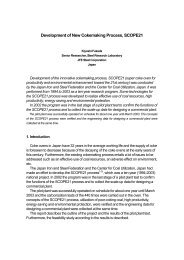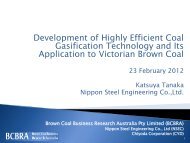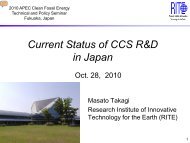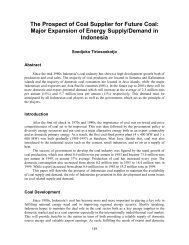CO2 S<strong>to</strong>rage <strong>Ready</strong> PlantExhibit 1-6: Illustration of Graduated Levels of Requirementsfor a CO 2 S<strong>to</strong>rage <strong>Ready</strong> PlantChapter 1: IntroductionComponent <strong>CCS</strong> <strong>Ready</strong> Level 1 <strong>CCS</strong> <strong>Ready</strong> Level 2 <strong>CCS</strong> <strong>Ready</strong> Level 3S<strong>to</strong>rage Site SelectionVerifying Injectivity,Capacity, and Integrityof S<strong>to</strong>rage SiteDesign of S<strong>to</strong>rageFacilityConflicting Uses andRightsCost Estimate forS<strong>to</strong>rage FacilityEnvironmental, Safety,and Other Approvalsfor S<strong>to</strong>rage SitePublic Awareness andEngagement Related<strong>to</strong> CO2 S<strong>to</strong>rage SiteSources forEquipment, Materials,and Services forS<strong>to</strong>rage SiteOngoing ObligationsEstimate <strong>to</strong>tal amount of CO2 <strong>to</strong> becaptured and s<strong>to</strong>red for all years of<strong>CCS</strong> operation of the plant, andidentify one or more feasibles<strong>to</strong>rage sites expected <strong>to</strong>accommodate the captured CO2.Review existing regionalprospectivity studies and showthat the required capacity istheoretically available; conductpreliminary assessment of s<strong>to</strong>rageintegrity and risks; and submit anoverall plan for site assessment.Prepare preliminary design fors<strong>to</strong>rage facility.In addition <strong>to</strong> Level 1requirement, obtain contractualoptions <strong>to</strong> one or moreappropriate s<strong>to</strong>rage sites.In addition <strong>to</strong> Level 1requirement, conduct desk<strong>to</strong>pstudy of injectivity, capacity,and integrity of s<strong>to</strong>ragelocation(s), and show that“effective” capacity isavailable.Identify any conflicting surface and subsurface uses, as well asfeasibility of access <strong>to</strong> site(s).Prepare preliminary economicanalysis for s<strong>to</strong>rage facility includingcapital and operation andmaintenance costs, and estimate thecost of s<strong>to</strong>rage for the capture plant.Identify all approvals that will need<strong>to</strong> be obtained for s<strong>to</strong>rage site.Notify public of eventual s<strong>to</strong>ragesite via web site and other actions.None.In addition <strong>to</strong> Level 2 requirement,obtain rights <strong>to</strong> one or moreappropriate s<strong>to</strong>rage sites.In addition <strong>to</strong> Level 2 requirement,conduct geological exploration <strong>to</strong>screen and select specific site(s) formore detailed characterization ofaquifers, or detailed assessment ofoil/gas options; estimate “practical”capacity and conduct initial modelingof long-term reservoir behavior; andprepare Detailed S<strong>to</strong>rage IntegrityRisk Assessment.Prepare technical feasibility In additional <strong>to</strong> Level 2 requirement,study for s<strong>to</strong>rage facility, prepare a Design Basis Memorandumincluding preliminary moni<strong>to</strong>ring (DBM) for s<strong>to</strong>rage site facility, includingand verification plan. moni<strong>to</strong>ring and verification plan.Conduct preliminaryeconomic feasibility studybased on technical feasibilitystudy, including the cost ofs<strong>to</strong>rage for the capture plant.Conduct feasibility studies forobtaining all approvals fors<strong>to</strong>rage site.Seek public engagement ins<strong>to</strong>rage site planning.Compile list of companies whocan supply equipment,materials and servicesneeded for construction andoperation of s<strong>to</strong>rage site.File periodic reports with regula<strong>to</strong>rs on status of s<strong>to</strong>rage ready.Resolve any issues with conflictingsurface and sub-surface uses, andsite access.In addition <strong>to</strong> Level 2 requirement,prepare follow-on economic feasibilitystudy based on technicalinformation provided in DBM.Prepare key documents for obtainingall approvals for s<strong>to</strong>rage site.In addition <strong>to</strong> Level 2 requirement,encourage public engagement ins<strong>to</strong>rage site approval process.Contact companies and negotiatenonbinding letters of intent <strong>to</strong> bid onproject.In addition <strong>to</strong> Level 2 requirement,respond <strong>to</strong> manda<strong>to</strong>ry triggermechanism <strong>to</strong> develop s<strong>to</strong>rage sitefor injection.Source: ICF <strong>International</strong>23 February 2010 20
Chapter 2: Capture <strong>Ready</strong> Plant <strong>Definition</strong>2. Capture <strong>Ready</strong> Plant <strong>Definition</strong>The definition of a Capture <strong>Ready</strong> plant focuses on identifying an appropriate location forthe plant, developing a plant design that is technically capable of retrofit, allowing sufficientspace for capture facilities, potentially pre-investing in some capture-related equipment, andensuring that any potential roadblocks (conflicting land use, environmental and otherpermits, public awareness, and identification of service providers) are recognized andaddressed. The key reason for including these elements in the definition is <strong>to</strong> allowpolicymakers, industry, and other stakeholders <strong>to</strong> avoid barriers that may prevent aneconomic transition <strong>to</strong> <strong>CCS</strong> retrofits within a reasonable timeframe. Not every jurisdictionwill have the same level of emphasis on each of these elements, but all of these issues areimportant considerations for an international definition of a Capture <strong>Ready</strong> plant. Moredetails on the proposed definition are presented below.2.1 Plant SitingThe location of a new plant is often decided early in the plant development and planningphase. The choice of the plant’s location will affect the overall technical feasibility and cos<strong>to</strong>f transportation and s<strong>to</strong>rage of the captured CO 2 . For siting a BAU plant, the issue ofCO 2 transport and s<strong>to</strong>rage is not a decision criterion; however, this criterion is crucial fora Capture <strong>Ready</strong> plant. The need <strong>to</strong> identify “reasonable route(s) <strong>to</strong> s<strong>to</strong>rage of CO 2 ” ismentioned in the IEA GHG definition, 15 although the report does not specifically addressthe issue of siting the capture plant appropriately in the first place.The need for appropriate siting is especially important for countries that are expected <strong>to</strong>have a large number of new CO 2 -emitting facilities and a wide range of onshore andoffshore s<strong>to</strong>rage options. In contrast, siting of plants may be less important in jurisdictionswith small geographical area and limited or mostly offshore s<strong>to</strong>rage options. In these cases,pipelines <strong>to</strong> transport the captured CO 2 from plant sites <strong>to</strong> appropriate offshore locationswill go short distances <strong>to</strong> trunkline transporting CO 2 <strong>to</strong> offshore s<strong>to</strong>rage sites.2.2 Technical Capability of RetrofitIn addition <strong>to</strong> locating the plant appropriately, an assessment of the technical feasiblity ofconstructing the future capture facilities and integrating them with the existing plant isimportant for ensuring that the current plant being built is technically capable of futureretrofit. Without such an assessment, it is possible that the retrofit will be either infeasibleor very expensive.The types of capture technologies will be a key fac<strong>to</strong>r in the technical assessments.Currently, there are three major CO 2 capture technology systems:• Post-combustion capture (relevant for all fossil fuel and biomass-based plants, includingindustrial facilities such as natural gas processing, hydrogen production, and ammoniaproduction);15 Page ii of <strong>International</strong> Energy Agency Greenhouse Gas R&D Programme (IEA GHG). (2007a). CO2 capture ready plants(Report no. 2007/4). Cheltenham, UK: Author.23 February 2010 21
















